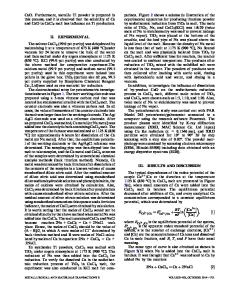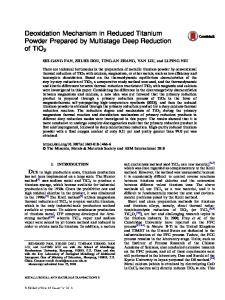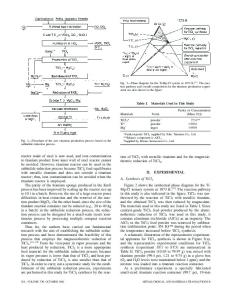Titanium powder prepared by magnesiothermic reduction of Ti 2+ in molten salt
- PDF / 2,486,545 Bytes
- 8 Pages / 612 x 792 pts (letter) Page_size
- 44 Downloads / 396 Views
I. INTRODUCTION
SOME new production processes such as hydridedehydride (HDH), gas atomizing, and plasma rotating electrode process (PREP) are applied for the preparation of titanium powder suitable to powder metallurgy.[1] However, these processes do not satisfy the reasonable price, fundamentally because they need the precast Ti ingot or compact as the starting material. To exclude the extra cost for ingot making, a specialized powder produced directly from its chloride looks promising.[2] TiCl4 is an indispensable intermediate compound for titanium metal production, and it has been used as common base material in the established titanium industries. In a modification of the conventional Hunter process (sodium reduction of TiCl4), a method has been industrially applied, where TiCl4 was dissolved as TiCl2 in the molten salt (main constitution is NaCl) after the weak sodium reduction.[3,4] When subsequent reduction by sodium is applied to the molten salt, the slightly sintered titanium called “sponge fine” powder is produced after the mechanical crashing. This powder is commercially supplied to powder metallurgy. When sodium is used as the reductant, however, there are some technical and economical problems in the handling of metallic sodium, NaCl removal, and sodium recycling by electrolysis of NaCl.[3] In the magnesium reduction (Kroll process), the electrolysis of its by-product, MgCl2, has been developed more efficiently and becomes economical by the improved operating techniques and modernized facilities. Considering the industrial backgrounds surrounding the Kroll process, we expect that the electrolysis of MgCl2 will RYOSUKE O. SUZUKI, Associate Professor, TOMOYA MATSUNAGA, Graduate Student, and KATSUTOSHI ONO, Professor, are with the Department of Energy Science and Technology, Graduate School of Energy Science, Kyoto University, Kyoto 606-8501, Japan. TAKUYA N. HARADA, formerly Undergraduate Student, Faculty of Engineering, Kyoto University, Kyoto, is Graduate Student, Department of Fundamental Energy Science, Graduate School of Energy Science, Kyoto University, Uji 611-0011, Japan. TETSUSHI N. DEURA, formerly Postdoctoral Fellow, Department of Energy Science and Technology, Graduate School of Energy Science, Kyoto University, Kyoto, is Scienific Staff with KOBE Steel, Ltd., Kobe 6512271, Japan. Manuscript submitted August 6, 1998. METALLURGICAL AND MATERIALS TRANSACTIONS B
be available, when we can reduce Ti21 in the molten salt using not Na but Mg. In the Kroll process, TiCl4 is fed to the top surface of the molten Mg, as illustrated in Figure 1(a). However, it could not produce the Ti powder. Its product was heavily sintered as “sponge” titanium. Recently, the authors proposed an alternative titanium production process, as shown in Figure 1(b), where the Mg melt floated on the heavier molten MgCl2.[2] When the gaseous TiCl4 was fed from the bottom of the molten Mg, metallic Ti powder could be successfully produced from TiCl4 in the Mg layer. The particles settled through the molten MgCl2 did not sinter
Data Loading...










